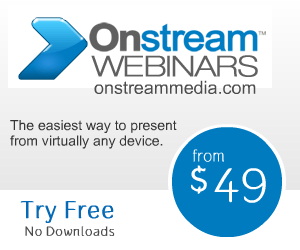The use of online video is a popular and effective way of communication, and one that continues to grow rapidly. This fact is not only evidenced by the advent of YouTube’s enormous popularity and influence, but also by the increasingly growing number of business professionals who use online video webcasting for everything from conferences and lectures to important meetings, sessions, interviews and sales. Through an online webcast, corporations and other organizations have the option to expand their circumference of influence by making the event available to a much larger, potentially even a worldwide, audience.
There are several advantages to using a webcast to communicate your service, product, brand or message to a wider audience. On the plus side, it's most obvious use is to span distances so that people can virtually attend an event without the expenses of travel, work time loss, and other various accommodations. A webcast, if well done, also extends a brand or message to potentially new clients, customers, or other interested parties, thereby radically increasing a company or organization's sphere of influence.
The key, however, to potentially reaching a global audience is for the webcast to be done well. In practical terms, this means that it should be planned with utmost care and precision, produced with high quality values, and delivered through the most efficient and practical means from the user end point-of-view.
A well-planned event is crucial to a successful webcast, and more effort should be devoted to this stage than anything else. You want the event to go smoothly and for viewers to have a seamless experience, so much so that they feel like they are there. The added value of an online webcast is precisely the illusion of presence, which fosters not only further interaction, but also builds a basic bridge of trust between the organizer of the event and the virtual “attendees”. It is vital to spend an enormous amount of time in thinking about scripting, direction, flow and message.
Prerecorded events should be meticulously written and executed, and edited well, that is in a non-distracting manner. A live webcast is more exciting, but also offers the possibility of things not going as planned (which is precisely what made early live television broadcasts popular – viewers wanted things to go wrong!) For your purposes, however, it is vital if you are producing a live webcasting event to build up to it through a series of test sessions in order to catch mistakes and refine your method. Also, with a live streaming webcast, it is absolutely critical that your venue has an excellent internet connection and that you have servers that can handle more traffic than your maximum expectations. On that note, your expectations should be rather high because for a live event, you will have pursued a rigorous marketing campaign to draw in viewers – depending on your purpose, either through paid advertizing, email, or social networking.
To hold the attention and interest of your viewers, it is very important to emphasize high quality production values, including (if possible) multiple cameras to add variety and energy to the presentation, superior video and audio, a well-lit venue, engaging and energized speakers who translate well to video, and direction that captures the energy and flow of the event without distracting from it. Poor production values will backfire, bore the viewer, and damage your brand. A scripted event can still feel and be spontaneous enough to keep interest, but a rambling, disorderly, badly-lit or monotonous event has the potential to bore, annoy and alienate potential clients or customers.
The objective should be a seamless, well-paced, energetic and informative, tight production. One way to accomplish this is to hire professionals – such as cameramen, grippers, directors and writers – who know what they are doing. Keeping the viewer entertained while also providing information is not an easy task for amateurs, though it is possible. However, it does take a lot of planning, work and patience.
Your webcast should also be easy for the user to access, connected to or imbedded within your website, and compatible with both Microsoft and Apple products, including mobile devices. You could put together a high quality event, but if users have difficulty accessing it, many will not bother to go to the effort. Making the event easily accessible from the technology end is therefore crucial to its success. If you stream a live event, you may want to make it available as a download later if that suits your purposes, which will also increase exposure and influence.




